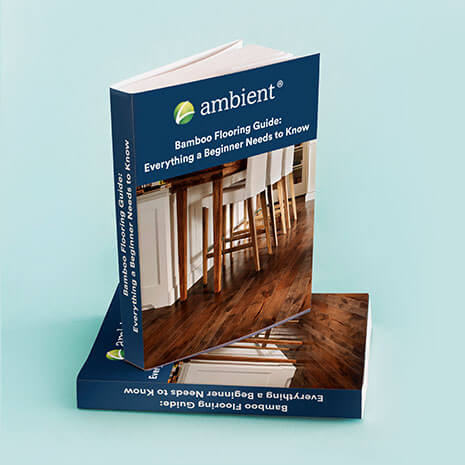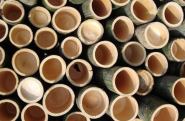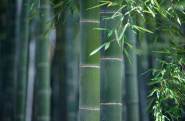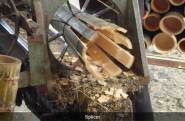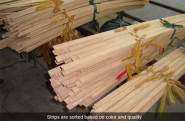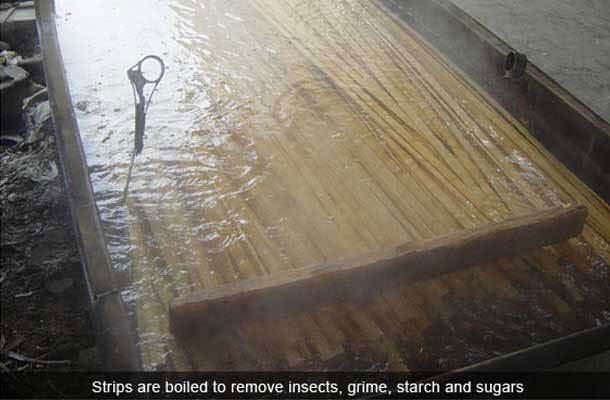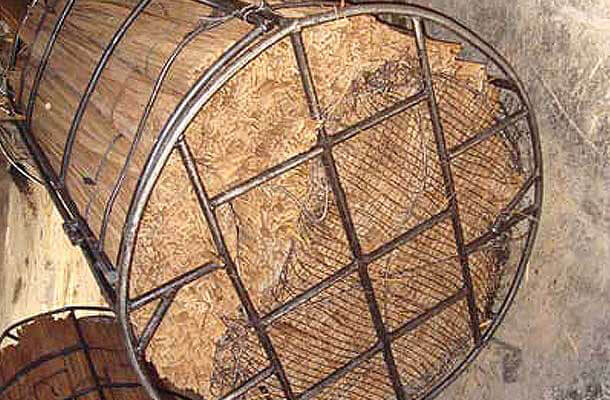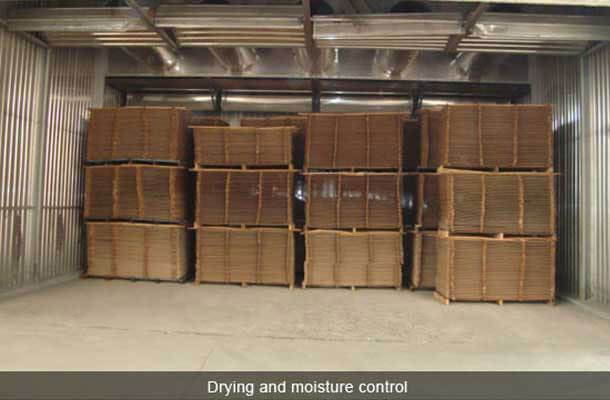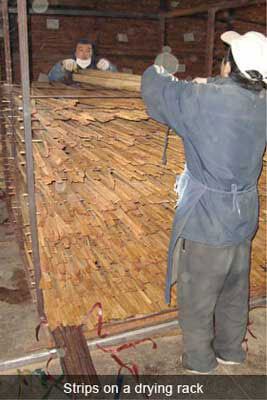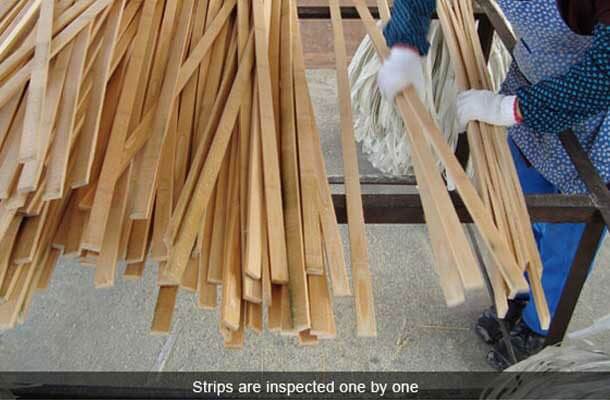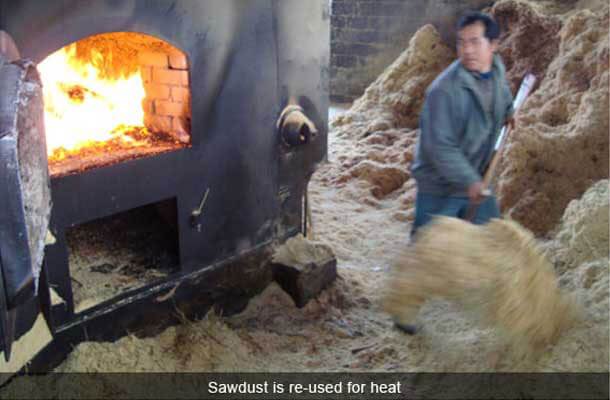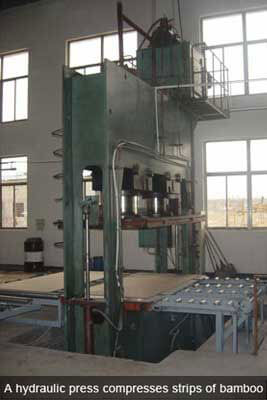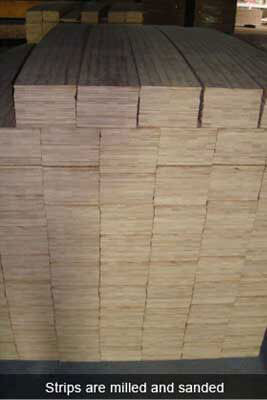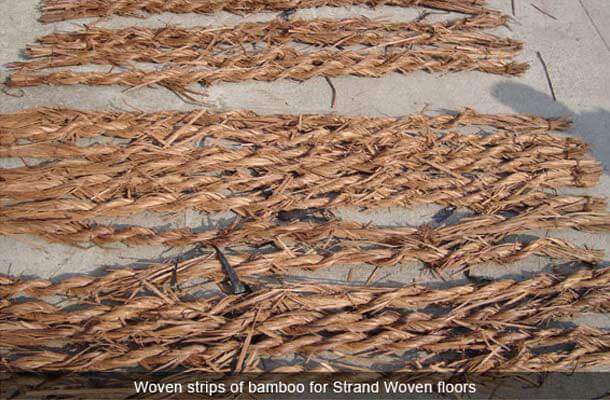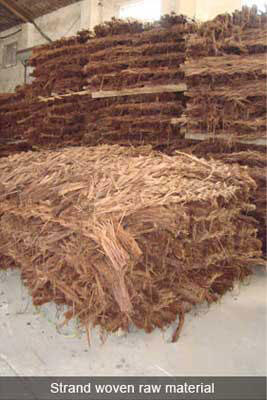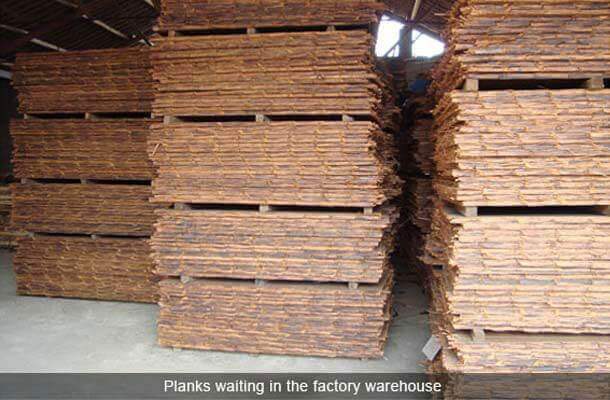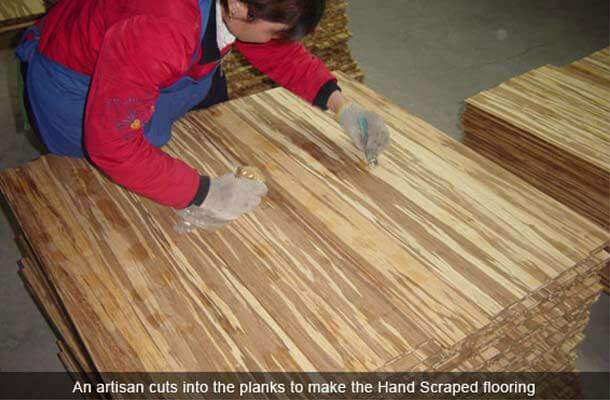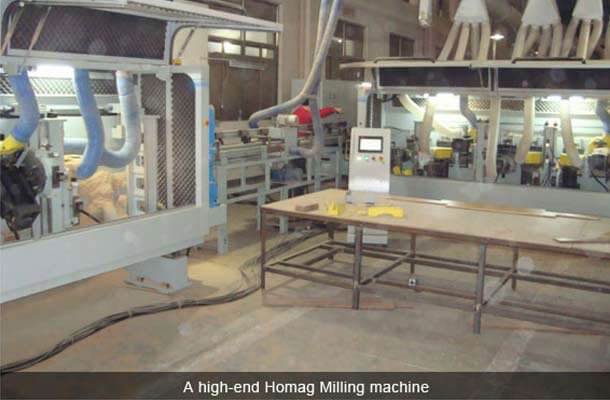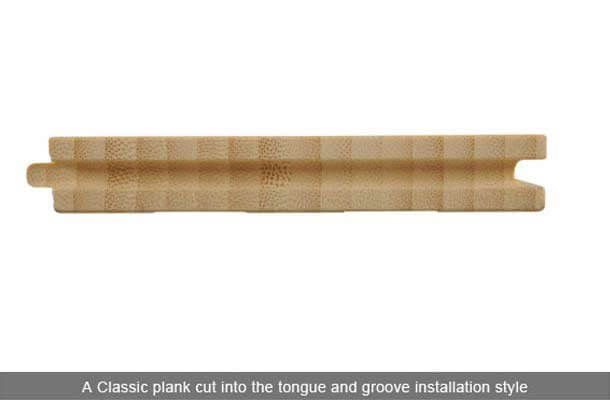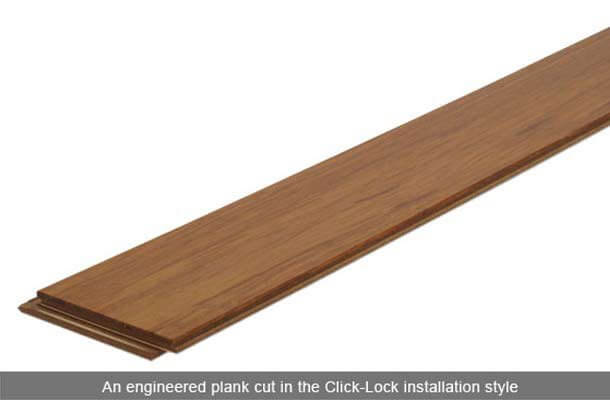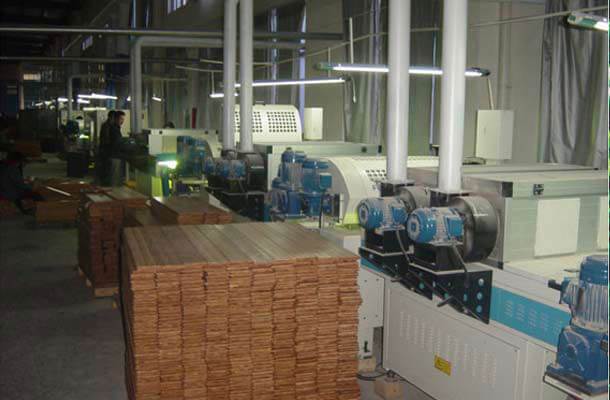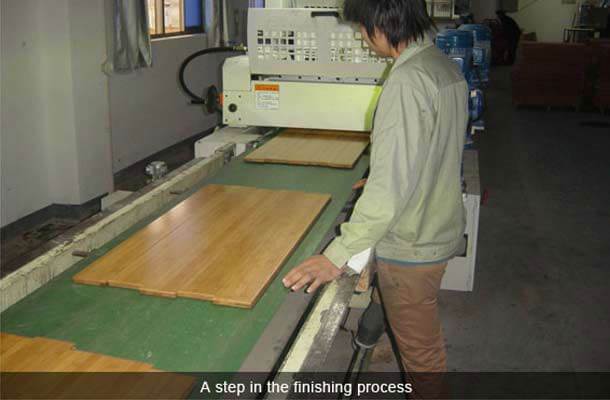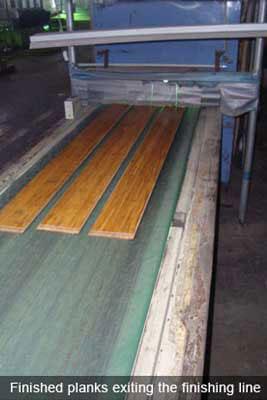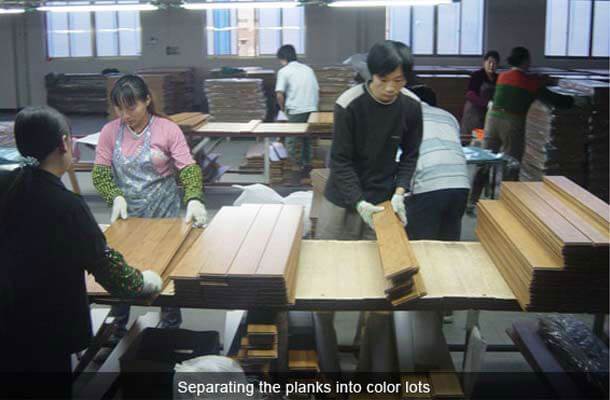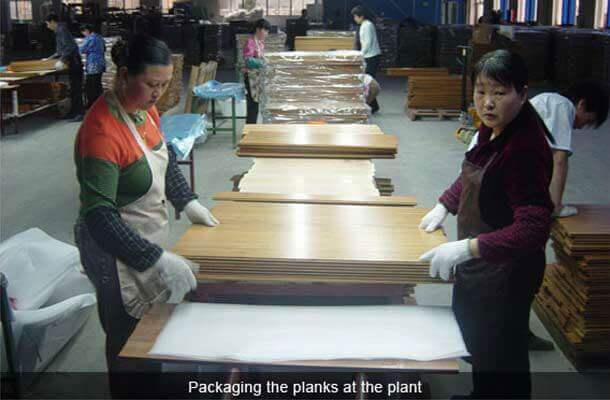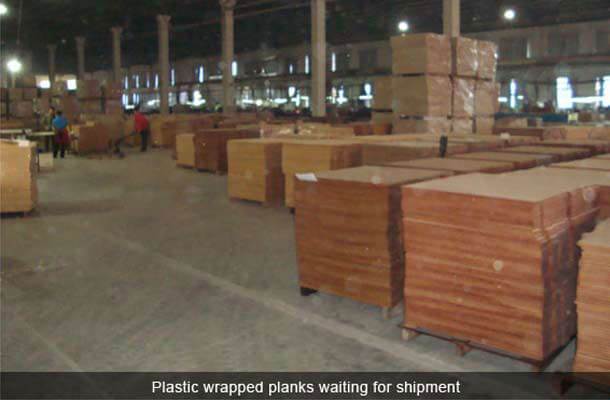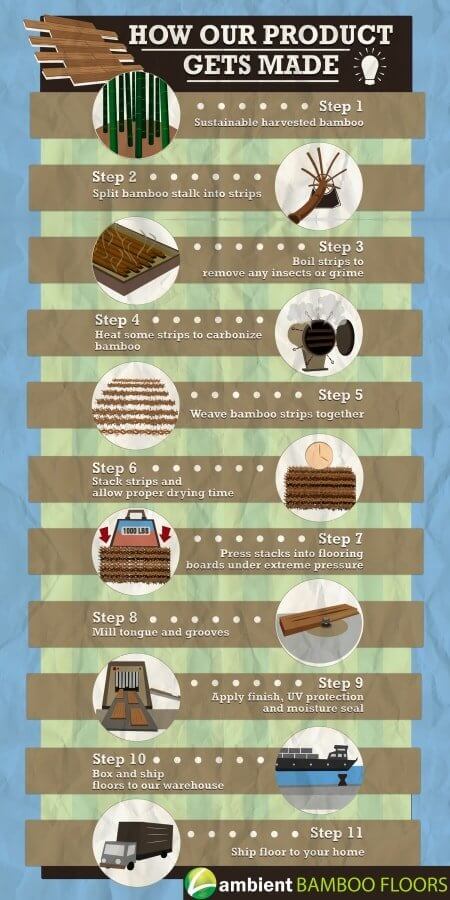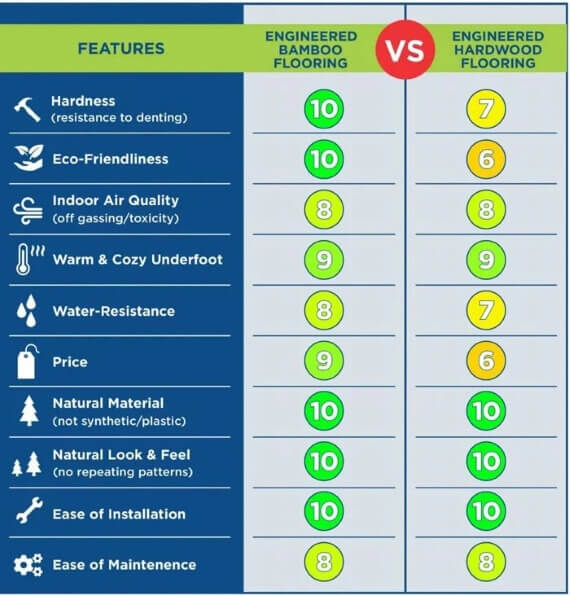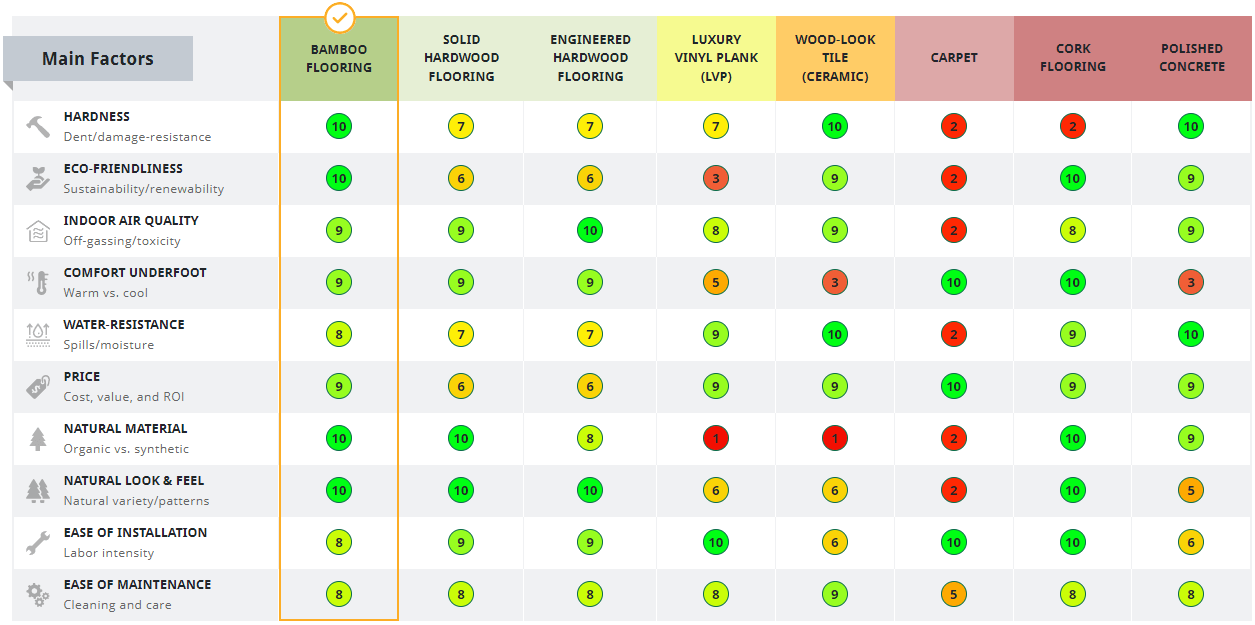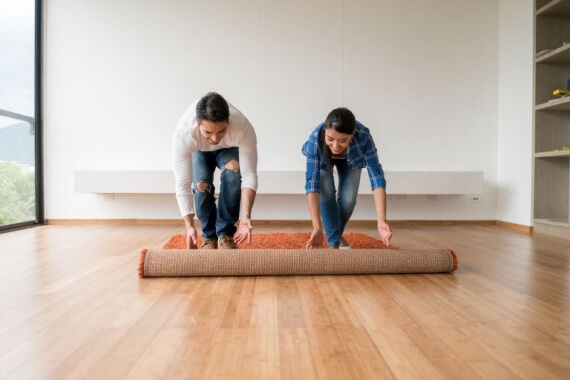Strand Woven
As much as 2-3X harder than oak, these tough floors provide a warm wood look and feel.
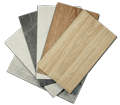

Looking to buy bamboo flooring? Start with our bamboo flooring store. If you want to learn first, this guide covers everything from durability to installation.
Bamboo is a recent addition to the flooring scene, only emerging in the mid-90s. To our dismay, there's a lot of misleading information about it online. This is partly because the original versions were less robust than the newer ones.
In 2005, Ambient® became one of the first companies in the world to sell strand woven bamboo flooring. Since then, we've shipped this incredible product to all 50 U.S. states, Europe, Africa, and beyond. We've had the pleasure of serving tens of thousands of homeowners, builders, and architects across the globe.
Over the years, we have amassed a wealth of information about this fantastic flooring material. We're excited to share all of it with you right now in this comprehensive guide. Rest assured that we'll cover everything from the types of flooring to the latest manufacturing techniques and environmental benefits.
If you have already decided to purchase and want to see prices, we recommend exploring our selection of bamboo flooring for purchase.
When it comes to hardwood flooring, bamboo floors stand apart in almost every category.
Strand woven bamboo is the hardest wood on the market (by far) and stands up to pets and kids.
It's made from a rapidly renewable resource, re-harvested every 5 years versus 40-80 years for hardwoods.
It can be refinished at least twice although it's rarely needed in a residential setting.
It's easy to clean, cutting down on allergens and dirt, and comes in weater resistant versions, making it great for kitchens.
It has a distinctive and unique marbled grain that is beautiful, inviting, and warm underfoot.
It comes in wide planks and premium lengths and cost $3-$8 per sq ft delivered, about half the price of comparable hardwoods.
Ambient® finishes meet the strictest indoor air standards in the world, such as CARB Phase 2.
It comes in solid, engineered, click-lock, tongue and groove and many more options and can be installed over concrete, in basements, and more.
As you learn about bamboo flooring, it's important to understand how manufacturers make it. Here are the details in a nutshell:
Want to know more? We make our eucalyptus flooring in much the same way. We use hand-picked raw materials that regenerate in as little as three years.
You've probably seen bamboo growing in your neighborhood or used as decorative material in all kinds of Tiki-inspired furniture - or maybe you even own a lucky bamboo plant. But you may still be wondering, "how does bamboo get from its plant form to be flooring?!"
It might seem like a crazy idea, but - when it comes to flooring - bamboo is no laughing matter. In a straight contest between bamboo flooring vs hardwood, bamboo wins for toughness, reliability, and sophisticated good looks! (Note from the editor: we may be slightly biased). But growing in the indigenous forests of China means that traveling from the depths of the wild to the floors in your home is a fascinating process. We'll take a closer look at this incredible product and how bamboo flooring is made below.
When all is said and done, you won't be asking how bamboo flooring is made anymore. This comprehensive guide provides so much helpful information that you'll be ready to harvest and develop your own bamboo products! Okay... maybe I'm overstating here. Don't try this at home!
Like mom used to say: If you want to make a blue-ribbon apple pie, you've got to start by using blue-ribbon apples. Our lovingly tended Moso (or Mao) bamboo grows for 5-7 years in managed forests free of pesticides, herbicides and other toxic chemicals. Individual markings detailing age and quality ensure that only the highest caliber bamboo stems (called culms) are selected for use during each harvest. Each stalk is cut from the middle of the bamboo (the trunk-like main culm) and subjected to a rigorous inspection before transformation into beautiful, durable Ambient flooring. Weaker culms are recycled and used for power in other parts of the manufacturing process or to make non-durable goods.
You can't shove a square peg through a round hole, and you can't make a flat floor using rounded bamboo stalks. That's why our skilled workers feed the hollow bamboo poles through a specially designed slicer, splicing them into thin, equally sized strips before peeling away their green outer layer. After splicing, the nodes (or joints between sections) are sanded down to create a smooth surface, resembling traditional hardwood. Unlike traditional lumber planking processes requiring massive, energy-guzzling machinery, bamboo splitting uses simpler, more efficient tools to get the raw materials from field to factory.
An ounce of prevention is worth a pound of cure, so when it comes to fighting off insect invasions, Ambient floors get a battery of booster shots. Improperly treated wood flooring — whether traditional hardwood or bamboo — inevitably rots or falls victim to timber-consuming parasites, resulting in expensive costs which can be easily avoided by purchasing a properly treated floor from Ambient. To prevent decay caused by impurities and to inoculate against current infestations at the hands of insects and other floor-destroying pests, Ambient's raw bamboo strips are boiled in a solution of lime acid to remove potentially damaging grime, insects, starches and sugars.
You guessed it, bamboo flooring is a natural blond (insert joke here). To achieve darker tones, bamboo strips are subjected to a process called carbonization. This carefully controlled, pressurized heating process affects the sugars deep within the bamboo's fibers, giving the entire strip a richer, darker color. Unlike staining, which simply changes the outer pigmentation of the lumber to which is it applied, bamboo carbonization changes the color of the bamboo all the way through, inside and out.
Like a perfect bowl of porridge, carefully managing the moisture content of wood floors is essential to quality and durability; too much or too little moisture can cause wood to shrink or swell after its installed. Our floors are tested meticulously for just the right balance of moisture. If moisture levels aren't up to Ambient's exacting standards, we dry the off-kilter strips in specialized kilns and then re-test them to ensure proper moisture content, maintaining our strict 8% +/- 2% standard for optimum dimensional stability. We test, and re-test, until we get this one right.
Once free of impurities and balanced for moisture, the bamboo strips are milled, sanded, and given an inspirational half-time pep talk to prepare them for the plank construction process. Milling machines cut the strips down to either strands, or a precise, standard width and thickness, before wide sanders smooth the surface of each strip to a uniform texture. At this point, some strips are turned into veneer for engineered floors. The sawdust created by this process is recycled to heat the kilns used for carbonization (Step 3).
Depending on which type of flooring is being made — traditional (horizontal and vertical), strand woven, or engineered — a different plank construction process will occur next. Below is an overview of each process.
Because the individual bamboo strips are only about an inch wide, multiple pieces must be pressed together to form planks. Ambient's vertical grain (also known as end-grain bamboo) floors are created by aligning the strips side by side before pressing, and horizontal grain (also known as flat-grain bamboo) floors are created by stacking the strips face-up, one on top of another. Once the strips are properly aligned, they are fused together using environmentally friendly adhesives and hydraulic pressure. Ambient's adhesives contain formaldehyde levels of less than 0.03 ppm — well below U.S. Occupational Safety and Health Administration (OSHA), European (E1 and E0) and California Air Resources Board (CARB) guidelines, and Ambient is proud to provide 100% formaldehyde-free floors on special order.
Bamboo strips are pulled apart into strands, which are woven together and compressed multiple times under extreme pressure and heat. Ambient's strand woven floors are almost three times harder than oak, twice as dense as classic bamboo flooring, and able to leap tall buildings in a single bound. Not to worry, we don't use harmful chemicals or glues during our compression process!
The top layer (veneer) of our strand-woven bamboo flooring is bonded to a tough, multi ply or HDF core and a recycled poplar base. The added dimensional stability on engineered planks means they won't suffer shrinkage or contraction as early as solid floating floors. Check out this page for more about the types of bamboo floors and their pros and cons.
After pressurization, the planks are inspected once again for gapping, irregularities and other problems to ensure they do not delaminate. Planks not up to Ambient's exacting standards are removed from the assembly line.
The term handscraped is usually used to describe a certain surface pattern rather than a type of floor itself. After making the cut, some floors are scraped by hand to create a distressed look. This surface style can be applied to strand and engineered bamboo floors alike.
High-quality locking floors click together in perfect unison, just like a good Grease song, the Rockettes, or a successful casino heist. The same goes for tongue and groove planks — the better the milling, the less gaps you will have when you slide the planks together. We know this all too well. Therefore, once the planks are successfully fused and double checked for irregularities, it's back to our German-engineered milling machines, which cut each board into either click-lock or classic tongue-and-groove flooring. For all floors besides the engineered variety, the underside of each plank is milled into a ribbed pattern for support and maximum dimensional stability. After milling, the planks are sanded on top to ensure a smooth finish application and once again, inspected plank-by-plank and by hand for quality.
When you're going outside in a thunderstorm you need a good rain slicker. When you're getting stepped on every day you need the toughest finish on the market. Our industry-leading 10-coat AccuSeal Ultra® Finish System is just what the doctor ordered. We apply a proprietary (shhhh... it's a secret!) top coating that makes our floors stand up for years while retaining their beauty.
All layers are applied and UV-cured individually to create uniform protection across the surface of the floor while the undercoat layers provide protection against sub-floor moisture. (please note the undercoats do not serve as a moisture seal!)
Like an ostrich in a chicken coop, an off-color or defective plank sticks out. Being overly meticulous is how we maintain our undisputed quality - via the industry's most thorough quality control inspections after our floors come off the finish line. Our commitment to using only the best raw materials, milling process and finishes has resulted in very happy customers and the lowest complaint ratio in our market.
At Ambient we inspect our flooring planks one at a time and even group them into similar lots according to color. This painstaking process ensures that we can back up our Lifetime warranty. By carefully sorting color shades we also ensure there's enough variation in each lot to reflect the natural beauty of the wood.
We wrap the bundled planks in plastic to protect them during shipment, and finally, enclose the bundles in cardboard boxes. Then, before sending them on their way to your home or office, we do a final quality control and color inspection to ensure all moldings match the floor and that your floor remains free of defects.
Bamboo flooring has the appearance of a hardwood floor and is often chosen over other types of natural floors because of it's beauty, eco-friendliness, durability, and affordability.
But technically bamboo isn’t a hard wood. Actually, it’s not even wood at all…it’s a grass. So that gorgeous bamboo flooring you’ve been eyeing up? It’s actually a grass floor.
However, before you run for the hills, you should know that bamboo is one of the toughest natural materials that can be found and in tests has been shown to outperform steel alloys, concrete and graphite.
Despite this unrivalled strength, bamboo is very flexible. Because of this, if you had to pick a place to shelter in the event of an earthquake, a bamboo forest would be one of the safest places on the planet! Homes made from bamboo have stood up to some of the fiercest earthquakes recorded, up to 9.0 in magnitude.
So, now you know that even though it’s not a wood….it’s something even better. Trust Mother Nature on this.
Cutting down bamboo from its natural habitat is tough work as you can imagine, but it’s even more mind-blowing when you hear more about the conditions in which it must be harvested.
Sugar in the sap must be at its lowest ebb when the bamboo is cut down for it to be in the optimum condition. This means that working during the day - when there’s the most light - is out of the question. Allowing the culms to age for 5 years is also important, as is using the middle part of the stalks.
Traditional methods calculate the best moon phase to harvest the bamboo which involves working during a waning moon, at dusk or dawn only.
Those of us that have bamboo in our gardens already know that bamboo regenerates extremely quickly. With the roots left intact, it can grow as quickly as four feet in just 24 hours if conditions are right.
Don’t worry about the pandas being deprived of their favorite tasty snack: the large bamboo culms used for wood flooring aren’t on the panda menu.
While we understand what part of and how the bamboo plant is harvested, this doesn't tell us how bamboo flooring is made! Harvested bamboo goes through a number of different stages to become the smooth, hard and elegant flooring you expect to see.
Firstly, the stalk is split down into strips which are then boiled to get rid of any insects, pests or grime. After this concoction has done its work, the strips are then heated and carbonized.
But there’s no time to sit back and relax as you aren't even halfway through the process of creating stranded bamboo flooring!
Next, it’s time to get weaving as the strips are woven together tightly before being stacked and left to dry for as long as is needed. These stacks are then subjected to extreme pressurization under intense heat that causes all of the sinewy strand of raw material to fuse together; this results in ultra-dense planks of bamboo which are super-galactic in their longevity and durability.
At this point the bamboo now resembles their hardwood counterparts, and you’d have a tough job identifying it as grass.
All that’s left then is to mill the tongue and grooves before applying UV protection, the finish, and the moisture seal treatment.
These finished pieces of bamboo are then boxed and shipped out to our warehouses and that ultimately could end up on the floor of your home.
This manufacturing process is incredibly detailed, with every single step carefully watched by our engineers to ensure we're shipping out only the highest quality strand woven bamboo flooring.
Bamboo undergoes a number of transformations to allow flooring manufacturers to capture its natural strength and durability. Strand woven bamboo processes create flooring which is unrivaled in appearance and performance, so go ahead and admire its golden, amber or rich coffee tones!
There are several different types of bamboo flooring on the market. Naturally, each has its own characteristics to consider. There are also different ways to manufacture each of them. Learning about these manufacturing processes can help you choose the best type of bamboo flooring for your project.
These are the six main types of bamboo floors:
Learning about different bamboo flooring options will help you choose the best one for your project. You'll also be more apt to avoid installation problems.
If you're looking for durability, we recommend strand woven bamboo; if you're looking for ease of installation, check out floating floors.
Bottom Line: The perfect combination of toughness, beauty, eco-friendliness, and affordability. You can choose to nail or glue it down (even on concrete), and there are no run limits. If you have kids or pets, it will hold up great, and you can use it in kitchens. Plus, it's available in premium wide planks at a fraction of what you'd pay for traditional hardwoods.
*A "run" refers to the consecutive distance the floor extends in any given direction
**Opening the windows in your home for a full day is okay.
Bottom Line: Floating solid wood floors tend to generate a lot of complaints about shrinkage. So homeowners should only install them in homes with very stable humidity. If you prefer a floating floor, we recommend using engineered bamboo flooring (not solid). These floors have a much higher dimensional stability and aren't nearly as susceptible to variations in humidity.
Bottom Line: Technically, this is an engineered floor due to its multi-layered design. However, it's different enough to warrant its own category! Here's why: it's highly water resistant, exhibits little to no expansion and contraction, and has an acoustic Ambient® vapor barrier pad.
Plus, you can install it directly on concrete or any other level surface as long as it's not too wet*. This floor is strong, comfortable, and durable, thanks to its stone polymer core and thick 40 mm wear layer.
* 'Excessively wet' is defined as emitting moisture > 20 lbs per sq ft as determined by a calcium chloride test . This usually includes a very small percentage of sub-floors. In these cases, you’ll first need to lay down a plastic vapor barrier sheet or something similar.
*A "run" refers to the consecutive distance the floor extends in any given direction.
Bottom Line: If you want to float a hardwood floor, engineered click lock bamboo is the way to go — it's tough, beautiful and easy to install. We recommend choosing an engineered floor with a minimum 2mm wear layer and high-quality 3-in-1 underlayment that has a high STC sound rating. The final product will look and feel exactly like a solid hardwood when you walk on it.
*A "run" refers to the consecutive distance the floor extends in any given direction.
**Opening the windows in your home for a full day is okay.
Bottom Line: Just like click lock engineered floors, this tongue and groove version is very stable for floating installations. The downside of a floating floor, however, is that they're a bit harder to install. Along the inside of each plank groove, you'll have to manually apply a bead of glue. You can also nail or glue this type of flooring down.
Bottom Line: If you want floors that look modern, you might like these. However, you won't want to use them in high-traffic areas because they are susceptible to denting and scratching. They are mid-range in terms of hardness and more similar to red oak than to strand woven bamboo.
When it comes to different bamboo grains, there are three main choices: horizontal, vertical, and strand-woven. Each has different characteristics that can help you decide which type of bamboo to put in your home or business.
This type of flooring is made by by cutting and slicing large dried strips of bamboo into smaller ones. The thin strips are then glued together into planks. Finally, they're pressed together using non-toxic adhesive, and glue.
Since bamboo is naturally light in color, sometimes the strips are stained to make them darker. Additionally, some go through a process of carbonization. Carbonized bamboo is softer but helps achieve a darker color if needed.
Horizontal bamboo commonly shows traces of the bamboo nodes. Hence, this type of floor tends to look the most natural.
Vertical bamboo typically looks a lot like horizontal bamboo. Why? The manufacturing process is similar - both are made by cutting large bamboo stalks into thin strips.
Instead of stacking and gluing the strips in a horizontal direction, however, they're glued together vertically. This vertical orientation hides the bamboo nodes.
Both sustainable and affordable, strand woven bamboo floors are super dense, the result of woven bamboo strands and compression under high heat. The end result is a super tough, dense flooring material.
Strand woven bamboo is very hard - in fact, it exceeds the hardness rankings of most other hardwoods. Its durability and strength make it one of the most popular flooring choices available on the market.
Like hardwood flooring, bamboo comes in various surface styles and textures. Customers have many options to choose from, including the following:
Like traditional hardwood floors, bamboo comes as both engineered and solid. "Engineered" means that the top of the plank consists of a wood wear layer that is laminated to a substrate. Manufacturers usually make this substrate from multi-ply wood or high-density fiberboard (HDF). Multi-ply is usually better quality and more resistant to moisture than HDF. A thicker wear layer generally indicates higher quality. Homeowners can also generally refinish engineered floors that have thick wear layers.
Both DIYers and contractors like engineered flooring because of how fast and easy it is to install. Its "floating" click lock planks also work well in basements. Moreover, both click-together and tongue and groove engineered floors can be glued down. Note, however, that you should never float solid wood floors.
Both types of bamboo are water-resistant up to 24 hours and rigid core engineered bamboo flooring is 100% waterproof. This means that you can install it in any room of the house, including bathrooms.
Both engineered and solid bamboo are extremely safe and durable. In fact, there is absolutely no difference in indoor air quality between engineered and solid. We recommend checking that the brand you choose meets the CARB Phase 2 indoor air standard and is FloorScore certified.
Traditional hardwood floors with planks wider than 4 inches and longer than 4 feet are considered "premium." As a result, they usually come with a premium price tag too ($8 per sq ft or higher). Conversely, due to its rapid regrowth rate, bamboo is available in premium planks at around half the cost. (Usually $4-$8 per sq ft delivered).
Selecting the right flooring for your home or your customers can be overwhelming, given the myriad of available options. To simplify your decision-making process, we've meticulously evaluated and compared the essential features of various flooring types.
It can be difficult to decide between bamboo and hardwood when choosing a new floor for your home. Both options look and feel great. In fact, at first glance, sometimes it’s hard to tell the difference between them!
However, they are, in fact, different from each other in several ways. This article compares bamboo flooring vs engineered hardwood and solid hardwood flooring and dives right into those differences. From cost to eco-friendliness to durability, there’s a lot to consider. Keep reading to learn more about these types of flooring so you can make an informed decision.
Below we’ve scored both flooring materials on a scale of 1 to 10, so you can easily compare them. Should you choose bamboo flooring or hardwood? This comprehensive comparison will help you decide!
There are several kinds of bamboo flooring. Some are harder than others. The Janka scale, an industry-wide method that assesses the hardness of bamboo and wood species, helps us compare them. The higher the Janka score, the harder the flooring, and the higher its resistance to denting.
Strand woven bamboo flooring, for instance, has a Janka score of up to 4000. Oak, the most popular type of solid wood flooring, on the other hand, only has a Janka hardness of around 1360.
The table below shows the Janka hardness for bamboo flooring and several popular types of solid hardwood flooring. It’s easy to see that strand woven bamboo is the hardest of them all (alongside eucalyptus).
So is bamboo flooring more durable than hardwood? The answer is a resounding yes. We give bamboo flooring a 10 out of 10 for hardness. Solid wood flooring, meanwhile, only scores a 7 out of 10.
Bamboo is one of the fastest-growing plants on the planet. In fact, according to The Guinness Book of Records, one species of bamboo holds the record for plant growth. It grows an incredible 35 inches a day!
Bamboo’s green credentials are highly impressive. Let’s list some of them below:
Of course, creating floors from bamboo plants does use some resources. But the plant compensates for this. As a result, we score bamboo a 10 out of 10 for eco-friendliness. We would give it a 10+ if we could!
Hardwood flooring is obviously a natural material. Since it comes from trees, you might think it has similar eco-friendly credentials to bamboo. That isn’t the case.
Most types of wood used for flooring come from managed forests. However, deforestation and illegal logging both remain issues. For more information on the environmental impact of this, see the video below.
Another problem is the slow growth rate of hardwood trees. An oak tree, for example, can take 20 to 30 years to mature!
Although there are even less eco-friendly flooring options out there, we still give hardwood only a 6 out of 10. Significantly less than bamboo for obvious reasons!
Many building materials emit VOCs (volatile organic chemicals). These can pollute your home with harmful toxins. Some, such as formaldehyde, can potentially cause cancer. And even small amounts of VOCs can affect people with asthma and other breathing issues.
Fortunately, VOCs are now strictly regulated, so the situation is much better than it used to be. However, it’s important to ensure that any flooring you install in your home is VOC-certified.
Bamboo flooring products are one of the safest flooring choices you can pick for your home. It’s not even possible to measure the level of VOCs in bamboo because it’s so minimal.
The only possible concern, and it’s a small one, is the adhesives used by flooring manufacturers. They can sometimes emit tiny amounts of VOCs. But the level is so low, it falls well below government regulations.
Thus, we award bamboo 9 out of 10 points for indoor air quality.
Hardwood flooring is also basically free of VOCs. Wood does naturally contain formaldehyde and other VOCs. However, the amounts are very small and highly regulated.
You can feel safe using hardwood flooring in your home. So, just like bamboo, we give it 9 out of 10 points.
Do you ever walk barefoot in your home? If you don’t, give it a try — your whole body will benefit, as you can see below:
Of course, you need the right floor to do this. Both bamboo and hardwood flooring are great options. Why? They are both naturally warm underfoot and comfortable to walk on (unlike cold tile, for example!)
We score them both a 9 out of 10 for comfort.
Bamboo flooring is reasonably water-resistant. As long as you mop up spilled water within 20 hours, you should be good to go!
It isn’t waterproof, however. If you let water sit on the floor for a really long time, it will likely cause damage.
We suggest wiping up spills as soon as they occur. Furthermore, avoid installing bamboo flooring in areas that are frequently wet. A kitchen is fine, but a shower room isn’t a good idea. It’s also advisable to remove wet shoes and boots before walking on a bamboo floor.
We rate the water resistance of bamboo flooring an 8 out of 10.
Hardwood flooring tends to be less water-resistant than bamboo. If you allow any water to soak into the wood, you will almost certainly damage it. And it will be almost impossible to fix without replacing that flooring section.
Wipe up spills quickly, and avoid walking on hardwood in wet shoes. Certainly, don’t install it in areas subject to frequent wetness.
We rate the water resistance of hardwood flooring a 7 out of 10.
People often choose bamboo instead of solid wood flooring because it costs less.
Why is it less expensive? Because it grows so fast and doesn’t cost a lot to harvest. Plus, it doesn’t have to travel far to get to the factory where it becomes beautiful bamboo flooring.
Hardwood costs considerably more per square foot than bamboo for several reasons:
Be prepared to pay up to four times more for a hardwood floor than you would for bamboo. Yes, you read that right!
Installers use the same methods to put down both types of flooring (nail down and glue down). Hence, installation costs the same for both materials.
Over the lifetime of the floor, bamboo typically costs less than hardwood floors. Why? It is easier to maintain and more water resistant.
Finally, homeowners can sand down and refinish both bamboo and hardwood planks. Since bamboo is harder than hardwood, however, it won’t scratch as easily or need refinishing as often.
We rate bamboo a 9 out of 10 and hardwood a 6 out of 10 for cost.
This one’s easy! Both bamboo and hardwood are natural materials. As a result, we give them both perfect scores in this category.
Both bamboo and hardwood flooring exhibit beautiful, natural variations in the grain with a superb look and feel that oozes quality. Moreover, they are both available in a wide range of styles and are highly versatile. They equally suit traditional homes, ultra-modern decors, and anything in between.
We give them both 10 out of 10 for natural variation in the grain.
Installing a bamboo floor isn’t generally too hard for anyone reasonably skilled at DIY. But it’s important to prepare the subfloor before you begin. You should also acclimate the flooring planks for at least 48 hours before starting the installation.
You can choose to install your bamboo floors in multiple ways. The easiest and fastest is the floating method, whereas the nail-down method is the most common and least expensive. The glue-down method is the most work but also the most stable.
Any carpenter or handyman can install the flooring if you feel unsure about doing it yourself. It’s only slightly harder to install than hardwood because of its weight and hardness. But we think this is negligible.
For ease of installation, bamboo scores an 8 out of 10.
Any DIY enthusiast or flooring installer should be able to put down solid wood flooring. If you’re doing it yourself, make sure to:
For ease of installation, solid hardwood gets a 9 out of 10.
Both hardwood and bamboo flooring are easy to maintain. Just make sure to regularly sweep and clean it with a soft brush or vacuum cleaner. Every week you should also use a specialist wood and bamboo floor cleaner.
We also recommend that you:
For ease of maintenance, we rate both bamboo and hardwood an 8 out of 10.
Let’s start by explaining what makes engineered wood and laminate flooring different. They tend to be easily confused because they can look similar to each other.
Laminate floors are simply plastic layers glued together. Engineered floors, meanwhile, include a top layer (either hardwood or bamboo) glued to an HDF or multi-plywood substrate.
Since the top layer of engineered hardwood comes from real wood, these floors look the same as solid wood floors.
Homeowners can refinish engineered hardwood floors that have a thick top layer. They can also install these floors by snapping the planks together without using glue or nails.
Engineered bamboo flooring provides all the pros of engineered hardwood flooring and then some!
Some inferior products only have an ultra-thin wear layer and cheap fiberboard layers underneath. It’s important to do your due diligence before buying!
It’s a relatively close call, but bamboo is the clear winner with 91 points compared to hardwood’s 82. Bamboo edges out its competitor in several notable areas: price, hardness/durability, water resistance, and eco-friendliness. It’s true that hardwood can be slightly easier to install than bamboo. However, in all other categories, they are neck and neck: indoor air quality, warmth, ease of maintenance, and more.
A lot of the decision comes down to personal preference. Either way, you can’t really go wrong. But bamboo is an excellent choice if you want to save money, help the environment, and achieve durability even in high traffic spots!
Beyond the materials themselves, there are significant differences between bamboo flooring and luxury vinyl flooring. Vinyl lacks the sustainability and naturalistic traits of bamboo. It does, however, beat bamboo in terms of ease of installation and maintenance.
This is not to say that bamboo is a tough install. The development of click-lock technology for engineered bamboo floors has considerably eased the installation process. Vinyl flooring — often referred to as luxury vinyl plank (LVP) or vinyl SPC flooring — utilizes similar technology. It is so simple that DIY-homebuilders can tackle it without professional help. Furthermore, these floors are similar in their affordability and water-resistant properties.
These points are only a surface level look into LVP versus bamboo flooring. There is so much more to explore: both in comparison and the decision process. If you are stuck in your deliberations between bamboo and vinyl flooring for your new project, then read on!
When choosing the right kind of flooring for your home, there’s a lot to get your head around. Bamboo? Laminate? Vinyl? There are so many options, and it can be more than a little confusing. When faced with such a choice, the traditional way of deciding is to make a pros and cons list. In other words, please list all the pros and cons of each choice and add it all up. Even Benjamin Franklin recommended the method!
However, according to the Harvard Business Review, that’s not always such a great way of making the optimum decision. It’s mainly down to what they call “cognitive bias.” A much better way is to quantify your list by scoring each feature on a scale of 1 to 10, with 10 being the most positive, and choosing the option with the highest score. Well, that is exactly what we have done for you here.
Many of our customers ask us about the differences between bamboo and LVP flooring. So we have listed all the most important features you should consider when choosing your floor, and we have assigned an objective score to each of them. Here is the table we came up with. We think the conclusion is fairly obvious, but we will leave you to do the math. After all, we wouldn’t want to be accused of cognitive bias. Following the table, we will go through each feature in some detail. Also, keep in mind that there can be significant differences in quality between flooring brands, so we recommend reading bamboo flooring reviews before making a purchase.
Bamboo — especially the strand woven bamboo — is tough. In fact, it’s one of the hardest floors available in the market, hands down.
Engineers measure the hardness and density of wood and other materials using the Janka Hardness Scale, which measures the force needed to drive a small steel ball into the material. On this test, strand woven bamboo consistently achieves ratings over 4,000, making it around 2-3 times harder than most traditional hardwoods.
Hardness is important for several reasons. The harder the flooring, the less susceptible it is to being dented by heavy furniture and heels. Another huge benefit to bamboo is that it rarely, if ever, needs to be refinished in a residential setting. This greatly lowers its long-term maintenance cost, and it increases the resale value of the home. Bamboo’s hardness rating of over 4,000 means that it is one of the most durable floors you can install, which is why we give it a score of 10 out of 10.
Luxury plank flooring is also a durable choice. Made from multiple thin vinyl layers and finished with a scratch-resistant coating, LVP is long-lasting, even in heavy traffic areas. However, it isn’t as hard as bamboo, so it’s more likely to be damaged by heels and heavy furniture. Vinyl flooring can be punctured with heavy, sharp objects, and the only repair is to replace the entire plank. We rate its hardness as 7 out of 10.
Bamboo is the most eco-friendly flooring you can find. Bamboo is really grass, even though the flooring looks like hardwood. It grows rapidly, sometimes several feet a day, and it matures in just five years. When we harvest bamboo, we do so without affecting the ecosystem in any way. We leave the roots in place so they can immediately start producing a new bamboo plant. We don’t disturb the soil or damage the wildlife, and we don’t even need any pesticides or fertilizers. This is why we score its eco-friendliness 10 out of 10.
The reason it is called vinyl flooring is that it is made from polyvinyl chloride or PVC. The US manufactures 14 billion pounds of vinyl flooring a year, which, frankly, is an environmental hazard. The manufacturing process of vinyl produces carcinogenic dioxins, which accumulate in the environment and pose a huge risk to the health of anyone who comes into contact with them. Other toxins produced include phthalates and ethylene dichloride, which both pose serious health risks.
Recent developments in LVP production, however, have changed perspectives on the sustainability aspect. Older models of luxury vinyl were less durable and would need replacement after as few as five years. The addition of stone polymer composite (SPC) core has lengthened the life expectancy of these floors. While the materials are still not the most eco-friendly, the longevity of these floors has reduced their environmental impact. For that reason, we have scored LVP a 5 out of 10.
Volatile organic compounds (VOCs) are gasses emitted by certain substances and can damage health, resulting in both short-term and chronic long-term problems. They are particularly harmful in homes if their concentration gets up to ten times higher than outdoors. It is advisable to minimize VOCs’ level in your home by making better choices of the materials you introduce and increasing ventilation levels.
You will be happy to know that bamboo produces tiny amounts of VOCs. Although trace amounts of UF adhesive are used in engineered bamboo flooring, it still only produces a tiny amount of VOC compared with other flooring materials. It’s so low; we give bamboo an air quality rating of 9 out of 10. The only floors for you and your family that are safer than bamboo (and it isn’t by much) are traditional hardwoods and linoleum.
During the manufacturing of LPV, quantities of materials such as dioxins, phthalates, and ethylene chloride (along with many others) are created. In some brands where toxins are not carefully controlled during manufacturing, these toxins may remain in the LPV after manufacture and can seriously affect your home’s air quality. The good news is that there are safe LVP brands with Floorscore Certification (an indoor air quality standard), but many brands do not. If you choose a high-quality brand that provides indoor air quality certification, you get an indoor air quality rating of 8 out of 10. Be sure to target brands with CARB Phase 2 certification because their products have proven to be safe.
There’s nothing like having a warm floor on a cold winter day, especially when you wake up barefoot for your morning cup of joe. Since bamboo is an excellent thermal insulator, it always feels warm to the touch. Without getting too technical, the thermal resistance of a material is resistant to heat flow: the higher the thermal resistance, the warmer and cozier the material will feel underfoot. Thermal resistance is measured in BTUs per hour using a complex unit h·ft2·°F/Btu, but we’ll call it R. The R-value for bamboo flooring is 0.72, while that of vinyl flooring is 0.2, making bamboo over three times as cozy. This is why we award it a warm and cozy underfoot rating of 9 out of 10.
As previously noted, the R-value for vinyl is 0.2, which is way below bamboo. Compared to other flooring materials, carpet ranges from 0.7 (about the same as bamboo) up to 1.6, while linoleum has an R-value of 0.26. LVP is a little better than plain vinyl flooring, so we award it a warm and cozy underfoot rating of 5 out of 10.
While bamboo flooring is generally more waterproof than hardwoods, that doesn’t mean it is entirely waterproof. If you spill water (or any other liquid) on the floor and wipe it up reasonably quickly with an absorbent cloth, there should be no staining or damage. But if you leave a pool of liquid on the floor for more than 20 hours, you might expect to see some staining and swelling. While you can install bamboo in areas with high humidity levels, it isn’t advisable to install it in areas like bathrooms, where it may be in frequent contact with water. Overall, we award it a water-resistance score of 8 out of 10.
LVP is more water-resistant than bamboo, and some LVP flooring is sold as waterproof. In fact, if you spill water on LVP floors, you can leave it to evaporate, and there won’t be any damage. There is an important caveat, however. If you install LVP on concrete, moisture can react with the concrete to create a highly alkaline solution, which is likely to degrade the LVP. So we decided to award it a water-resistance rating of 9 out of 10.
Both bamboo and LVP flooring have similar price points, and both are widely available online and in local stores. You can get high-quality bamboo and LVP shipped to your home for between $3 to $7 per square foot. This is significantly less than hardwood, which can be several times more expensive. And while they’re both budget-friendly, you won’t be a trading cost for quality if you choose the right brand. Bamboo is as good, if not better, than hardwoods in every way, and LVP can also be an excellent choice. They both deserve a price rating of 9 out of 10.
Bamboo is a 100% natural material with many eco-friendly qualifications. It is sustainable, doesn’t damage the environment, and soaks up copious quantities of carbon dioxide during its rapid growth cycle. You can’t get more renewable or natural, therefore our score of 10 out of 10.
As it says on the package, luxury vinyl planks are vinyl: a human-made plastic derived from crude oil. Vinyl flooring also includes many additives such as phthalates, which are non-biodegradable. It will remain in the environment forever, and it creates several harmful toxins during its manufacturing. Score: 1 out of 10.
One of the more attractive features of bamboo is its highly unique and marbled grain pattern. No two planks will ever be identical, and they will differ subtly in their color, tone, and grain pattern. This natural variation can be used effectively when installing a bamboo floor.
HELPFUL TIP: Work from all your boxes of planks simultaneously to obtain a uniformly-varying, natural variation finish across your entire floor. We award bamboo a natural variation rating of 10 out of 10.
Although printed and made of plastic, “wood-look” veneers have come a long way. There’s no denying that even the untrained eye sees that “something isn’t real” about synthetic floor surfaces. Since LVP is entirely human-made, there is no natural variation. Using high definition printing, it can still look great and can be made to have the appearance of wood. But in the end, there will be repeated patterns and planks that look too similar, in addition to just looking, well, a bit fake.
That almost covers the main differences between bamboo and LVP floors. However, there is an additional feature of both of them: their ease of installation. A reasonably skilled DIY enthusiast can easily install both, but LVP is often a little easier since it can be laid over surfaces that are not perfectly flat. Hardwoods, bamboo, and tile all require level sub-floors. However, you do need to be careful that you don’t install LVP floors directly over concrete. As we have already mentioned, any dampness can react with the concrete to produce alkali, degrade the vinyl. Altogether for ease of installation, we will score bamboo 8 out of 10 and award LVP full marks – 10 out of 10.
Cleaning LVP and bamboo are similar, both can be maintained with a lightly damp mop, and both are highly resistant to moisture. However, Rigid Core Luxury Vinyl Plank LVP has a small leg up because it can be steam mopped and wet mopped, which you should mostly avoid with bamboo and hardwood flooring. For this reason, we give LVP a 10 and Bamboo an 8.
We said we would leave the math to you, but we can’t help ourselves, so here you go!
Bamboo Flooring: 91 points
Luxury Vinyl Plank: 70 points
This is the conclusion we’ve come to based on the metrics provided. At the end of the day, it is your decision as far as what floors to choose for your project. We at Ambient have a vested interest in bamboo products, but there are benefits to all sorts of floors. Although we did the math for you, it’s up to you to decide whether it adds up.
The great news is that both of these products are especially affordable. It makes it easier for prospective buyers to consider their own preferences rather than a restrictive price barrier. Is eco-friendliness or a natural look important to you? Is your new floor going to experience high traffic — in which case toughness is a priority? These are the questions to consider.
Let us know what you think is best for your own situation! The decision is in your hands — er, under your feet.
Engineered bamboo flooring and engineered wood flooring are composite products made up of several layers, of which the upper layer or “wear layer” is either bamboo or real hardwood. The other layers may be plywood, hardwood, or high-density fiberboard. These layers are glued together, often in a cross-grain configuration, to minimize sensitivity to changes in humidity. But which of these has the edge? Here, we provide you with a detailed comparison of the two flooring options and score the most important features out of ten. So, add up the scores, concentrating on what is most important to your home improvement project. It’s the best way to make a decision.
Engineered bamboo flooring options, especially the strand woven variety, is made from the hardest natural flooring material you will find – strand woven bamboo. It is considerably harder than the hardest of hardwoods, so it is highly resistant to denting. That doesn’t mean it’s totally indestructible, but it’s dang near close, as far as flooring goes. We’ve even seen bamboo flooring used as a flooring surface in home garages – so people park their cars on it! We measure the hardness of wood species by using the Janka scale, which measures the relative hardness of wood by measuring the amount of force required to embed a .444-inch steel ball to half its diameter into a material.
It is worth reading if you want to understand how some woods are much harder than others. For hardness and resistance to denting, engineered bamboo scores 10 out of 10.
As we have already said in the previous paragraph, bamboo is much harder than hardwood, so you might expect it to be much harder than engineered hardwood. You would be right in this assumption. The top hardwood layer determines the hardness of engineered wood flooring, so it is the same as hardwood and much less resistant to denting than bamboo, on average. It gets just 7 out of 10 for hardness. Speaking of heavy things on wood floors, here is a useful tip on moving an upright piano that doesn’t involve heavy lifting.
Most of us take for granted that the air we breathe in our homes is reasonably pure. However, that is a big mistake. It’s up to ten times more polluted than the air outside. The main culprits are (VOCs) emitted from all the stuff in our homes, including building materials, carpets, paints, and so forth. These pollutants potentially damage your health, so we advise you to keep them to the minimum. Proper ventilation helps make good decisions on the materials you use for your home improvement projects.
Engineered bamboo flooring produces only a small quantity of VOCs, which comes from the adhesive used in its manufacturing process to glue the various layers together. However, you don’t need to worry about this because the levels are well below government recommended VOC limits. You can safely install engineered bamboo floors without any risk to your health from VOCs. We give it an indoor air quality rating of 8 out of 10.
You don’t need to worry about engineered wood flooring, either. Its structure is similar to engineered bamboo flooring, and it emits similarly low quantities of VOCs. So, it also scores 8 out of 10. We doubt if you’re old enough to remember The Hollies’ take on the air that you breathe – but it is a classic!
Kick-off your shoes and stretch your toes. What can feel better than walking barefoot on an engineered bamboo floor? We weren’t made to wear shoes. Bamboo floors feel comfortable and warm because bamboo, a grass, has a very low thermal conductivity, so it doesn’t drain the heat away from your feet. Walking barefoot is good for your health, too; here are several benefits it offers. Don’t worry; you won’t get any splinters. Additionally, since most engineered bamboo is installed over a 3-in-1 underlayment, you’ll get the added benefit of some cushioning for your back. For the comfort of walking, engineered bamboo achieves 9 out of 10.
Can you tell the difference between engineered bamboo floor and engineered wood floor just by walking barefoot on them? If you can, then you must have susceptible feet. We don’t think there’s much of a difference, so engineered wood flooring also scores 9 out of 10 for the comfort of walking.
One of the crucial benefits of engineered bamboo flooring compared with hardwood is that it is more water-resistant. Therefore, you can install it in kitchens and other places where it is likely to get wet occasionally. As long as you wipe up any spills reasonably quickly (within 24 hours), you are good to go. Although water droplets will dry up, you’ll want to avoid leaving puddles on bamboo for more than 24 hours, or you’ll risk the bamboo staining and swelling. One reason bamboo is more resistant to water than hardwood is its structure. Because it is grass, it doesn’t have the same kind of porous grain structure as hardwood, so it doesn’t soak up water quickly. For water resistance, we give it 8 out of 10.
Engineered wood flooring is less waterproof than bamboo for the reasons we give in the previous paragraph. It can tolerate a small amount of water, but you should wipe spills up as soon as you can. You don’t have 24 hours of grace as you do with bamboo. It’s not the best solution for areas such as your kitchen, where you would always worry about damaging it. For water resistance, it scores 7 out of 10.
When comparing apples to apples in terms of thickness of the wear layer, engineered bamboo flooring is much cheaper than any comparable (same plank dimensions) wood floor. This is because it is highly sustainable, grows exceptionally quickly, and reaches maturity in just five years. It can also regenerate after harvesting, so it doesn’t need replanting, which prevents soil erosion. It is readily available, so don’t worry about encountering any shortages. Additionally, engineered strand bamboo flooring rarely, if ever, needs to be refinished in a residential setting. It isn’t scratched by pet claws – instead of engineered hardwoods, which look all dented up after a few short years – so the life-cycle and long-term value of bamboo are much higher. It scores 9 out of 10 for pricing.
Engineered wood flooring costs considerably more than bamboo; its costs are similar to those of solid hardwood. This is because trees take a long time to grow, with most flooring species taking 40 years or more to grow to maturity. Like bamboo, it is readily available. For pricing, we give engineered wood flooring 6 out of 10.
Engineered bamboo flooring is entirely natural. We agree that a little glue and resin are used in its manufacturing process, but in minuscule quantities. Other than that, it is 100% natural. Since you can’t get more natural than nature, engineered bamboo flooring scores 10 out of 10.
Engineered wood flooring has the same natural credentials; after all, it is made mainly of wood, though a small quantity of glue and resin is used to manufacture it. Engineered hardwood flooring also scores 10 out of 10.
Strand weaved engineered bamboo flooring looks and feels very similar to hardwood flooring, which is why many people choose it. Its grain pattern has a truly unique marbling effect that looks gorgeous. If anything, bamboo is even more exotic; see for yourself in the picture below. It’s a picture of strand woven engineered bamboo flooring that demonstrates its beautiful color tone and grain. Every plank is unique, and you will never find a repeated pattern. For natural variation in the grain, it deserves full marks: 10 out of 10.
Because the surface of engineered wood is a natural hardwood, it will always exhibit a natural variation. The amount depends on the grain size, growth rings, and knots, and just as with bamboo, every board will have its special character. There is no doubt, a good quality engineered wood floor will always look great; we give it 10 out of 10.
Both engineered bamboo and engineered hardwood are easy to install, thanks to the click-lock systems they both use. No gluing or nailing is needed, so it’s much easier to plan to do the installation yourself. The necessary steps for installing these flooring options are:
For ease of installation, both engineered bamboo and engineered hardwood flooring score 10 out of 10. Here is a detailed guide on installing engineered bamboo flooring.
Maintenance on bamboo or hardwood floor is easy. Ideally, you’ll vacuum your floor a few times each week or sweep it using a soft brush broom. Avoid harsh detergents and acidic or alkaline products, and never use wax polish or abrasive materials. You can mop the floor using a lightly damp microfiber mop, but avoid excess water and dry the floor after mopping. That’s all you need to keep your floor looking great for many years to come. For ease of maintenance, both engineered bamboo and engineered hardwood flooring score 8 out of 10. Alternatively, sit back and let somebody else do the work!
Have you been keeping a check on the score? Both engineered bamboo and engineered wood flooring are excellent options, but engineered bamboo flooring has the edge in the final analysis. The final scores are: Engineered bamboo: 93 points Engineered hardwood: 81 points
Strand woven bamboo is considerably harder than any of its horizontal or vertical cousins and all conventional hardwood flooring — by far. This can be hard to believe because bamboo is actually a grass instead of wood. But experts classify it as hardwood flooring for a reason - because it is extremely hard and durable.
To make bamboo so tough, manufacturers weave long strips of raw bamboo together. (Hence the name "strand woven.") Then they expose these woven mats to high heat and machines fuse them together.
The resulting flooring planks rank much, much higher than any other hardwood flooring on the Janka Hardness Scale. So high that strand woven bamboo is way harder than even Brazilian Walnut (sometimes called Ipe), Ebony, and Bolivian Cherry.
Is bamboo flooring water-proof? The answer is Yes – if you buy the right bamboo floor. Rigid core SPC bamboo flooring is waterproof as long as you don’t leave spills unattended for long periods of time, and is resistant to damage from typical damp mopping or normal household spills that are not left unattended. Most flooring warranties do not cover flooding, leaking pipes, household mechanical failures, appliance leaks, pet urine, or puddles left unattended.
Most other non-rigid core bamboo floors, like solid bamboo flooring or engineered bamboo with eucalyptus core, are highly water-resistant. Strand woven bamboo flooring handles water spills better than conventional hardwood flooring and typically provides you with spill protection from puddles for up to 24 hours.
It’s also important to remember that most traditional bamboo are floors (horizontal and vertical grain varieties sold in the big box stores) can warp due to excessive moisture.
All wood and bamboo flooring materials are hygroscopic. That means the fibers absorb moisture from the environment.
When you first buy your flooring, acclimate it for 5 to 7 days before installing it. (Read more about how to prepare for bamboo flooring installation.)
The moisture content of flooring continues to drop until it matches the amount of moisture in the air. That’s the equilibrium moisture content of the flooring and it changes with the temperature and relative humidity of the surrounding air.
Bamboo is more structurally stable than hardwood, but it still is impacted by moisture – just not as much. The better the finish, the better the protection of the wear layer against moisture intrusion. In the same amount of time, hardwood flooring swells, cups, and warps.
Some of the most commonly-asked questions we get are about whether bamboo flooring is waterproof, how the floors handle spills, and how moisture affects them. Hardwood and bamboo floors in the average home work hard – they must resist damage, and do so while remaining beautiful.
A key element of durability is water resistance. High-moisture rooms like bathrooms, kitchens, and utility spaces, as well as entrance areas where wet or muddy boots may traipse require water-resistant flooring.
The easy answer to this is Rigid Core Bamboo Flooring. This flooring is waterproof due to it’s ultra-stable limestone composite core and stranded bamboo wear layer. And if you use a version with a pre-attached IXPE or natural cork pad, you get additional protection from subfloor moisture!
Bamboo flooring, especially strand woven bamboo and brands with spill-protective finishes, endures moisture and standing water very well. Extended moisture exposure (in non rigid-core bamboo floors) leads to warping and distortion called cupping. The term cupping refers to the concave shape of the center of the board. Cupping results from more than spills. High humidity levels, improper acclimation, and subfloor moisture also cause cupping. We recommend cleaning standing water as soon as possible.
Yes – bamboo flooring works great in kitchens: water droplets left on it will evaporate over time, with no harm to the floor itself. Strand-woven bamboo floors are also great for kitchens because of their hardness (more than twice as hard as most hardwoods). Even after years of use, they will still look great in high-traffic areas.
Most hardwood floor manufacturers (including us) don’t provide a warranty on their full bathroom products. However, many of our clients install our floors in bathrooms without any problems. As a general rule of thumb, if you frequently use the bathtub (like bathing your children) and water spills over the tub or splashes in copious quantities, you probably should avoid putting bamboo or hardwood flooring in the bathroom. On the other hand, if you only have a shower stall or you rarely use your tub, you can typically install a bamboo floor in a bathroom with zero problems. Just make sure to place protective mats or rugs at the entrance to the bathtub.
Some people ask if they can put bamboo flooring underneath cabinets or islands, so check out our article Flooring Under Islands and Cabinets.
Bamboo provides natural beauty, but don’t expose it to nature. That means no outdoor installations. Keep it out of your gazebos and off your patios and decks.
Please don’t put it in any room with a pet washing station. Pet washing stations are increasingly popular in mud rooms and laundry rooms. If you’ve ever bathed a dog, there’s a LOT of splashing that goes on and that’s not great for any wood flooring. Even the Girl with the Dogs has a tile floor for her dog washing station.
Keep solid bamboo out of the basement. Only install solid bamboo above grade. Engineered click-lock bamboo flooring can be floated in basements, however.
Bamboo flooring is a superior choice for the environmentally conscious consumer. Unlike traditional hardwoods, bamboo is a rapidly renewable resource that reaches maturity in just a few years. This means that it can be harvested more frequently than hardwood trees, which can take decades to mature. Bamboo does not require replanting once harvested, as it regenerates on its own. The unique marble grain of strand bamboo and eucalyptus flooring is not only beautiful but also distinctive. Moreover, high-quality manufacturers, such as Ambient®, use eco-friendly and non-toxic finishes and adhesives in the manufacturing process, making it a healthier choice for both the environment and human health.
Bamboo is a rapidly-renewable resource because of how quickly it grows. Although there are many species of bamboo, all of them are evergreen and belong to the grass family Poaceae. The fastest-growing plant in the world, bamboo is used in a variety of ways. Sometimes people eat it, use it as paper, or make it into household products like cutting boards and kitchen cabinets.
To be sustainable, a product must:
Some smaller varieties of bamboo can grow an astounding three feet in only 24 hours. Incredible! The best kind for flooring is a "giant" variety called Moso bamboo. These amazing plants use energy from the sun to build massive root systems called rhizomes.
During the first four years, there's no evidence of this growth underground. New plants will break through a year later, though, growing at an explosive rate for about six weeks.
Native to China, Moso bamboo commonly grows to heights of 40-80 feet. The bamboo grows in clusters (groves), with taller plants emerging each generation.
The first generation of Moso bamboo plants will grow to about 10 feet tall. As this happens, the bamboo grove has more leaves pulling in energy from the sun, and the root system grows stronger. As a result, the batch of plants that push up the next spring can grow even taller!
Now the grove has even more leaves and the root system gains more strength and grows wider. The pattern of higher plants each spring continues for 8-10 years, at which point the grove reaches its maximum height.
Bamboo plants generally live about 10-15 years, depending on the variety. And, interestingly, the grove continues living even when a single plant dies or is cut down. It simply uses its energy to replace the plant.
As you read lots of bamboo flooring information online, you may come across poor reviews about bamboo. Some homeowners and installers have had bad experiences with low-quality brands. Here's where we set the record straight about common bamboo myths and misconceptions.
When bamboo flooring first came about in the mid-1990s, it had a bad reputation for being soft and vulnerable to scratches and dents. However, advances in manufacturing have brought forth certain types of bamboo that are more durable than the hardest traditional hardwoods. On the Janka hardness scale, strand bamboo has a rating of more than 4,000—harder than the strongest teak, cherry, rosewood, or walnut.
This usually happens when using poor-quality brands or when rooms have wildly varying humidity. In both cases, you'd have the same problem with hardwood floors. As with all floors common installation errors are easily avoided by taking 20 minutes to read the installation instructions.
It’s true that pandas do eat bamboo, but not the bamboo used to make our flooring. In fact, pandas don't even live in the areas where we harvest our Moso bamboo.
While it’s true that some products made in China are low-quality, there are also very high-quality products made in China, like iPhones, Mercedes, and all Ambient® products! Reputable suppliers carefully control the manufacturing process and supply chain, and enact strict quality control processes to ensure the products are superbly crafted and hyper durable.
Strand woven bamboo is virtually pet-claw proof from a "permanent denting" standpoint, as even the largest dogs can't apply enough force to leave permanent marks. This is precisely one of the main reasons why homeowners choose strand bamboo.
As for micro-scratches on the surface, there is no surface on earth (diamond floors, anyone?) that won't scratch when hit with something sharp enough, so no floor is scratch-proof. To minimize scratches from furniture and everyday activity, and keep your floors in tip-top shape, try these tips:
Bamboo can indeed be refinished, we even have a guide on how to do it: How to Refinish Bamboo Flooring. What you can't do to bamboo is stain it on site — but you can certainly sand it down and then add several clear coats of polyurethane. Also, if you take proper care of your floor it will last you decades, and if you purchase a high quality bamboo product, it's highly unlikely you will ever need to refinish it (under residential foot traffic) due to its insanely dense composition and resistance to moisture and high traffic.
Many hardwoods harvested in the Americas, Europe and even Asia are first shipped to China for milling and finishing, and then shipped back to retail locations around the world. That's two shipments compared to one (bamboo grown in China and shipped out from there). Also, due to its incredibly fast regrowth rate, bamboo forests generate orders of magnitude more biomass than their hardwood counterparts and take about 1/10 of the time on average to regrow for harvest. Additionally, when bamboo is harvested, the plant isn't killed, unlike trees used for wood. New growth emerges every spring. So continually harvesting bamboo is much better for the environment than waiting decades for hardwoods to grow and damaging the soil when cutting them down. For an in-depth read on how bamboo is eco-friendly, check out our article Examining the Effects of Hardwood, Cork and Bamboo Flooring on the Environment.
Just like traditional hardwood flooring, installers can nail, glue, or float bamboo. Want to read Ambient's official installation guide? We have both an English Version and a Spanish Version available for you!
Anyone can install our floors as long as they're comfortable working with tools and can read our simple installation guides. If you are planning to hire a professional, however, we recommend you read our helpful article 7 Tips To Choose a Good Floor Installer.
Whether you're installing it yourself or have hired a professional, here are a few general tips:
Many consumers see bamboo as a luxury flooring material and it can be easy to assume that installation costs come at premium rates. You might be surprised to find that bamboo flooring can be reasonably priced — both to purchase and install. Don’t assume the cost of installing bamboo flooring is outside your home renovation budget: it’s actually right in line with hardwood floor installation costs!
Did you know this natural and eco-friendly flooring is more than twice as hard as most hardwoods? Did you know that it costs about half as much per square foot? Bamboo is certainly a savvy investment — you can get premium lengths and widths (6 foot wide planks) for as little as $4.37 (as of December 2019). Add that to its incredible durability and hardness — and that it’s gorgeous with a capital “G” — and it seems easy to make a case for bamboo as the best and most practical flooring installation. Since bamboo is considerably cheaper than other hardwood options, it makes a great material for affordable home improvement projects!
Those benefits aside, if you’re working with a budget like most homeowners, you also need to consider the installation cost. This post explores how bamboo flooring installation costs fare when compared against traditional hardwoods.
As mentioned, the cost of installing bamboo flooring can be compared to that of traditional hardwoods, which generally come in at between $2-$5 per square foot. Here are the four main factors that will affect your installation costs.
The average flooring installation is around 800 square feet. If you have less than this, installers will typically raise their installation cost per square foot to cover their costs (and earn a living!). If you exceed 2,000 square feet, installers may drop their price to give you a discount.
Will the installer need to rip up existing tile or hardwood flooring? Will they need to level the subfloor? Will they need to move furniture? Will they install perimeter moldings such as baseboard or shoe molding? Do you want the installer to bring the flooring into the house for acclimation? These are just a few of the items that can increase your installation cost, as they can be time-consuming and labor-intensive.
Needless to say, installation costs in densely packed or difficult-to-access areas like New York, Santa Catalina Island, or rural areas mean more transportation overhead for the installer and means higher installation prices.
Your installation costs may also depend on the type of installation required for your chosen flooring.
The glue-down flooring method is the most stable type of flooring installation but also the most expensive. It’s the most stable because the adhesive elasticity allows the wood to expand and contract naturally through the seasons. If you can afford high-quality glue, it will provide two great additional benefits: sound and moisture insulation. Additionally, if you’re planning to install over a concrete subfloor, the glue-down method is essential. It’s more expensive from an installation perspective because it’s messier and more labor-intensive than nailing or floating a floor.
The nail-down method is affordable and fast. However, over time the nails may come loose and cause squeaking in the floor due to seasonal expansion and contraction. Don’t confuse this with loose nails in the subfloor, which is the main culprit for wood floor squeaking.
Some installers will provide a discount to install using the click-lock floating method because they go much faster than glue-down or nail-down jobs. The limitation here is that, depending on your home’s indoor humidity settings, you may have limitations to the lengths of your runs.
It pays to take the time to consider your new bamboo flooring installation options for your home. Installation is often an underestimated process and may require:
NOTE: It’s a job that anyone can do, but it’s much easier for practiced DIY’ers. Even then, it’s necessary to arm yourself with plenty of knowledge before you start.
We’ve calculated, based on average American room sizes, the following installation costs:
You’re probably wondering how to maintain your bamboo flooring so you can enjoy it for many years to come. The good news is that cleaning your flooring is pretty easy! However, there is more to it than just sweeping and mopping. Especially if you want to keep your bamboo looking its best. Check out our Cleaning & Care Guide for Bamboo Flooring to learn everything you need to know about proper flooring maintenance.
It can be a challenge to ensure that the bamboo flooring you're getting is high-quality and eco-friendly. Unfortunately, as a newer flooring product, it isn't officially rated. So it can be hard at times to know what you're purchasing! The best approach is to work with a reputable dealer or manufacturer that has a proven track record.
Nowadays we need to be vigilant about what we eat, breathe, and touch. Chemicals are everywhere. When it comes to bamboo flooring, however, they are perfectly safe as long as test results show less than .05 ppm.
In fact, bamboo floors generally off-gas less than even your wood dining room table or office desk!
Having said that, trace amounts of phenol-formaldehyde resin and urea formaldehyde are used in the production of strand woven and engineered bamboo floors. Experts consider the flooring safe, however, because the amounts are so small.
It is important to recognize, though, that cheaper flooring by shady suppliers can give off formaldehyde emissions between .2 ppm and .3 ppm (parts per million). Higher quality flooring brands meet the very tough CARB Phase II, OSHA (Occupational Safety And Health Administration), and NAUF (No Added Urea Formaldehyde) standards. European and American Indoor Air Quality recommendations allow for .1 ppm and below.
For more information about formaldehyde, please visit our Bamboo Flooring and Formaldehyde information page.
Many factors impact the price of bamboo floors, including the size of the installation area, bamboo type, quality, brand, and labor costs. As of our latest udpate, bamboo costs about $3 to $6 per square foot on average. In comparison, hardwood flooring typically costs $4 to $8 per square foot for standard materials like hard maple or red oak. More unusual hardwoods can cost upwards of $10 per square foot. Use our handy Square Footage Calculator to calculate the square footage of your room.
There are some other aspects that can affect the cost of installing bamboo floors. These can include supplier cost differences; the cost of subfloor installation, preparation, or floor removal; molding and baseboard repair or replacement; and staining and finishes.
No. Stain isn't the reason it's darker. Instead, the raw bamboo has undergone a special process of kiln-heating. This carbonization process darkens the natural sugars found in the plant, giving the finished planks a darker color. This color goes all the way through the plank, just like natural bamboo.
A common misconception is that this process softens the bamboo. This isn't true in regards to strand woven bamboo, however, and only applies to old "classic" bamboo (horizonal and vertical grains). Classic bamboo is only about 1/3rd the hardness of strand woven bamboo.
Yes, but we suggest using only engineered bamboo flooring for floating installations. Why? Because floating solid wood or bamboo products can result in problematic expansion and contraction.
For ease of installation, use click-lock planks that fit together and “snap” into place. This type of installation is incredibly easy because it doesn't require any glue or nails. Even brand-new installers can usually do this without any problem.
Bamboo holds up incredibly well in most moist conditions. (Within reason! Don't dump buckets of water on your floor and let it sit there.) Since bamboo is actually grass and not hardwood, it tends to tolerate moisture well.
In fact, we have installed our floors in humid climates all over the world. Examples include Guam, Kenya, Hawaii and all across the Southern US. Even the Dry Tortugas National Park off the coast of Miami!
That being said, you should follow NWFA guidelines regarding humidity levels inside the home. Most importantly, as with any wood floor, avoid swings of more than 20% in humidity throughout the year. Also, be sure to acclimate your flooring for at least 72 hours. Lay it flat on the floor in the room where it will be installed with the boxes and plastic cut open.
Absolutely! In fact, due to its hardness and moisture resistance, strand bamboo is great for kitchens, laundry rooms, and even basements. In fact, we've installed our floors in many kitchens throughout the world. We've also installed it in restaurants, spas, yoga studios, university dorms, lecture halls, and many other high-traffic locations.
Additionally, with Ambient®'s floors you get our super-tough Accuseal Ultra® finish with aluminum oxide. This provides top-notch spill protection from puddles and stains.
You're likely here because you want an answer to the burning question: is bamboo flooring good for kitchens? Well, indeed it is - for these reasons:
Now, let's tackle some of the worries you might have about choosing bamboo flooring for your kitchen. Trust us; it won't take long to see why it's the perfect choice for this room in your house.
In other words, is bamboo flooring good for kitchens and bathrooms where there's water and humidity? In fact, it is because bamboo handles moisture well.
Some bamboo, like rigid core bamboo flooring, is 100% waterproof. Can't beat that! All prefinished bamboo flooring, meanwhile, is pre-sealed to protect against liquids and moisture. Plus, most strand bamboo provides up to 30 hours of spill protection from puddles.
So if your bamboo flooring gets wet, simply wipe up the spill — it’s that easy! This is one of the many reasons why bamboo flooring is a popular choice among homeowners for kitchens and bathrooms.
We can all appreciate that bamboo floors withstand water so well. But what about dirt and grit and spills? Is this type of flooring easy to clean?
We're happy to report that bamboo and vinyl are two of the easiest flooring materials to keep clean (yay!) They both have smooth, slick surfaces that don't trap dirt or dust.
Routine care using regular bamboo flooring products will keep your bamboo kitchen floor looking like new!
The simple answer is yes - as long as you plan to nail or glue down your bamboo floor planks. Nailed or glued-down bamboo can handle the weight of kitchen cabinets or an island just fine.
If you plan to float your flooring, however, you shouldn't install it under your cabinets or island. This is a general rule of thumb for all flooring materials. Floating floors – no matter the material type – aren't designed to hold all that extra weight.
To get all the details, check out our helpful guide on how to install bamboo flooring under cabinets and islands.
Yes! Why? Because bamboo rarely dents. In fact, strand woven bamboo is the hardest type of flooring available on the market.
Don't believe us? Look at the world-renowned Janka hardness scale. You'll find it listed right at the top.
Did you know that making strand woven bamboo requires 1,800 metric tons of pressure? That's equivalent to 3,968,320 pounds or around 345 elephants sitting atop the flooring to compress and harden it. Whoa.
In fact, its hardness beats out every single type of traditional hardwood, including teak, cherry, rosewood, and walnut.
So when people ask us if engineered bamboo flooring is susceptible to scratches, we say absolutely not! Although nothing is 100% scratch-proof, bamboo flooring comes close.
On top of all that, high-quality bamboo flooring typically has a finish that protects it from stains and moisture.
To learn more, read our article: Does Bamboo Flooring Scratch Easily?
This durability makes strand woven bamboo an excellent choice for your kitchen floor. No worries if you drop a soup can, cast iron skillet, or heavy appliance. Walk all over it day in and day out, and there still won't be any dents to speak of. Trust us, you won't be able to find a better flooring material for your kitchen!
Naturally, you wonder how bamboo will look in your kitchen. Will it match your decor? Does it come in different textures and finishes? How does it compare to the look of wood floors?
Rest assured that bamboo comes in various finishes. Even better, some of them help hide stray scratches (which, as we established above, are rare):
If you're unsure how bamboo will look in your kitchen, Ambient® offers the option to order a free sample piece. Hold it up to your furniture and walls. Compare various types of bamboo flooring before committing. We understand - it's an important decision.
If you buy your bamboo flooring from Ambient®, its Accuseal Ultra® premium finish will protect it. You won't have to worry about stains or damage from moisture.
However, there are several easy things you can do to keep your beautiful floors safe:
One of the best things about bamboo flooring is that you probably won't ever need to refinish it. As we've mentioned already, it is extremely durable, long-lasting, and scratch-resistant.
However, what's even better is that if you ever WANT to refinish it for whatever reason, you can! And then it'll look brand new again for a fraction of the original cost. Nice!
To refinish your bamboo floor, simply sand down the surface and apply a fresh coat or two of finish. For more details, check out this in-depth article about how to refinish bamboo flooring.
The easy answer here is no, most likely not. While there are pros and cons to everything, one advantage of bamboo flooring is its moisture resistance.
In fact, rigid core bamboo flooring is highly water resistant. Wow!
Strand woven bamboo, meanwhile, offers 24-hour protection against spills and puddles. It withstands water better than most types of hardwood. Moreover, it'll retain its shape after drying out (no warping).
So, in other words, no worries if you spill tomato sauce on the floor or drop a hot casserole. Wipe it up, and it'll be like it never happened.
The only liquid that's an issue is pet urine. Like every other type of floor, urine can cause damage if left on it for more than 14 hours.
Well, that sounds awful. Nobody wants mold growing anywhere in their house, honestly. Fortunately, this is one thing you don't need to worry about at all with bamboo flooring.
Not only is bamboo environmentally friendly, it's also naturally hostile to mold. So even if you leave water on your floor, chances are basically zero that you'll ever see any mold. Thank goodness!
We do advise calling in a professional, however, if your kitchen ever floods.
Nope! This is a common myth about bamboo.
High-quality bamboo is actually much better at handling humidity than most other floor options. In general, it won't shrink or swell.
If you DO notice any shrinking or swelling, it's likely the result of:
In most scenarios, bamboo floors handle humidity without any issues - even in a hot and heavily used kitchen.
Cleaning a bamboo floor is easy. Honestly! You won’t need to do anything special. Simply sweep or vacuum it like you would any other floor.
To clean it more thoroughly? Occasionally, use a lightly damp mop and an approved hardwood floor cleaning solution.
As a reminder, never steam mop a bamboo floor - or any hardwood floor, for that matter. (This would introduce way too much moisture.)
For a full set of care instructions, feel free to check out our bamboo flooring cleaning and care guide.
And there you have it. Hopefully, we've answered the burning question of the day: Is bamboo flooring a good choice for kitchens? In our opinion, it's not only good, it's great. Why? Let's list the reasons one more time:
So how good is bamboo flooring for kitchens? You'd better believe that it's an amazing flooring option. Give it a try - order your free sample today!
Yes! You can install bamboo over concrete in two ways. You can either float it or glue it down.
If you choose to glue it to concrete, use an all-in-one/vapor barrier adhesive, compatible trowel, and adhesive remover wipes for cleanup. If you float the flooring over concrete, use a 3-in-1 vapor barrier underlayment. For more details, check out our bamboo flooring installation page.
We recommend adding 10% for cutting and waste. But this can vary slightly depending on your skill level and the layout of your room. If installing the flooring in a diagonal pattern, you'll need to add 15%.
There are 10 main bamboo moldings that you may need to use depending on your particular installation. We list them below:
Yes! You can install bamboo flooring in a bathroom, as long as you take care to protect it from moisture. For example, use mats by the bathtub and shower entrances. As long as you're careful not to let the water sit, bamboo floors work great in bathrooms.
The best time of year to install both bamboo and hardwood flooring is during the spring and fall. Although you can install them any time of the year, the less humid and cooler months work best.
It tends to be more humid in the summer. If the flooring absorbs too much of this moisture, the wood will swell. Conversely, during the dry months (winter), the flooring may shrink and gap. If proper expansion gaps haven't been put into place, this can cause buckling issues.
Absolutely! In fact, due to its hardness, bamboo is much more suitable than traditional hardwoods to handle light commercial foot traffic.
Bamboo floors are commonly used in:
You can find Ambient® bamboo in Elevation Burger locations worldwide and even in university student unions and restaurants.
The carbonization process only softens "classic" bamboo (vertical or horizontal) — not strand woven bamboo. This is because the carbonized color is the same hardness as the natural color of strand woven bamboo - the raw materials are compressed to the same density. Hence, there is no real difference between carbonized and natural strand when it comes to hardness.
In general, you can clean your floors with a Swiffer or any type of lightly damp mop. Do try to treat your floors similarly to hardwoods, and avoid leaving excessive moisture on the floor while cleaning. For more information, check out our handy cleaning guide.
Here are some tips on how to clean your floors:
When you think of the bamboo plant, you probably think of bamboo forests in Southeast Asia. Wild pandas may also come to mind. However, most of the world's rapidly-regenerating bamboo grows in China. The soil conditions and climate are ideal for it there.
Moso bamboo, used for flooring, is not the kind of bamboo that pandas like. Nor do they rely on this bamboo to feed themselves. In reality, Moso is primarily used for flooring. People typically harvest, mill, and manufacture it close to the forest where it actually grows.
Yes! In fact it qualifies for LEED credits under multiple categories. Check out our guide to Bamboo Flooring and LEED Credits
Although "better" is often subjective, bamboo does have some advantages over traditional hardwood. Here's a quick look at what the two popular types of flooring have in common and how they differ.
The Similarities:For a more comprehensive write-up, be sure to read our Bamboo vs Hardwood Floors Side-by-Side Comparison.
Both are made from a hygroscopic material. This means that they tend to absorb moisture from the air. This diagram clears up any confusion about how and why expansion and contraction occur (hint: it's all about the humidity!):
There are steps you should take before, during, and after installation to prevent expansion and contraction issues. For example, be sure to acclimate your floors properly. Additionally, install them with expansion gaps as needed. And keep the humidity levels in your home stable.
Also, it’s advisable to use engineered bamboo if you live in an area where humidity levels fluctuate throughout the year.
Aside from diamonds, almost no material in existence is 100% scratch-proof. Hence, all floors are susceptible to scratching. Especially when they come into contact with heavy furniture or sharp objects.
These scratches aren't as visible on white bamboo hardwood flooring as they are on darker woods. Fortunately, homeowners can easily fix micro-surface scratches. They can do this either naturally by friction (foot traffic) or with a flooring product like the Tibet Almond Stick.
When it comes to denting, however, strand woven bamboo really stands out. It is extremely hard and dense. It's nearly impossible to permanently damage it outside of using excessive force.
Don't believe us? Grab a free flooring sample and go at it with a hammer. Then you'll see why so many pet owners choose stranded bamboo. It stands up to it all!
Yes! However, in this case, it's important to keep the humidity between 40-60% or your flooring might have issues. If the humidity is too low, shrinkage or cracks might occur. If it's too high, the bamboo might expand and later buckle.
Manufacturers usually finish bamboo with several layers of UV protection. However, over time sunlight can cause most flooring to fade. But there are ways to protect it. Some options include using drapes, blinds, or UV films on your windows.
Keep in mind that in sunrooms and atriums - rooms purposefully filled with light - it might not be possible to protect your flooring without using UV films.
Despite all its benefits, sunlight can harm both skin and building materials. Constant and direct sunlight (especially from southerly-facing windows in the U.S.) can fade almost any product in your home. This includes furniture, carpets, paint, electronics, plastics, and more.
We've made it easy for you to compare all the important features of the floors you're considering, from pricing and shipping to warranty and indoor air quality. You can even compare hardness ratings and other key features side-by-side. So don't wait, download our handy-dandy cheatsheet today and make the flooring selection process a breeze.
Download Cheat Sheet PDFSign up for our newsletter to get the best deals on all of our products!
